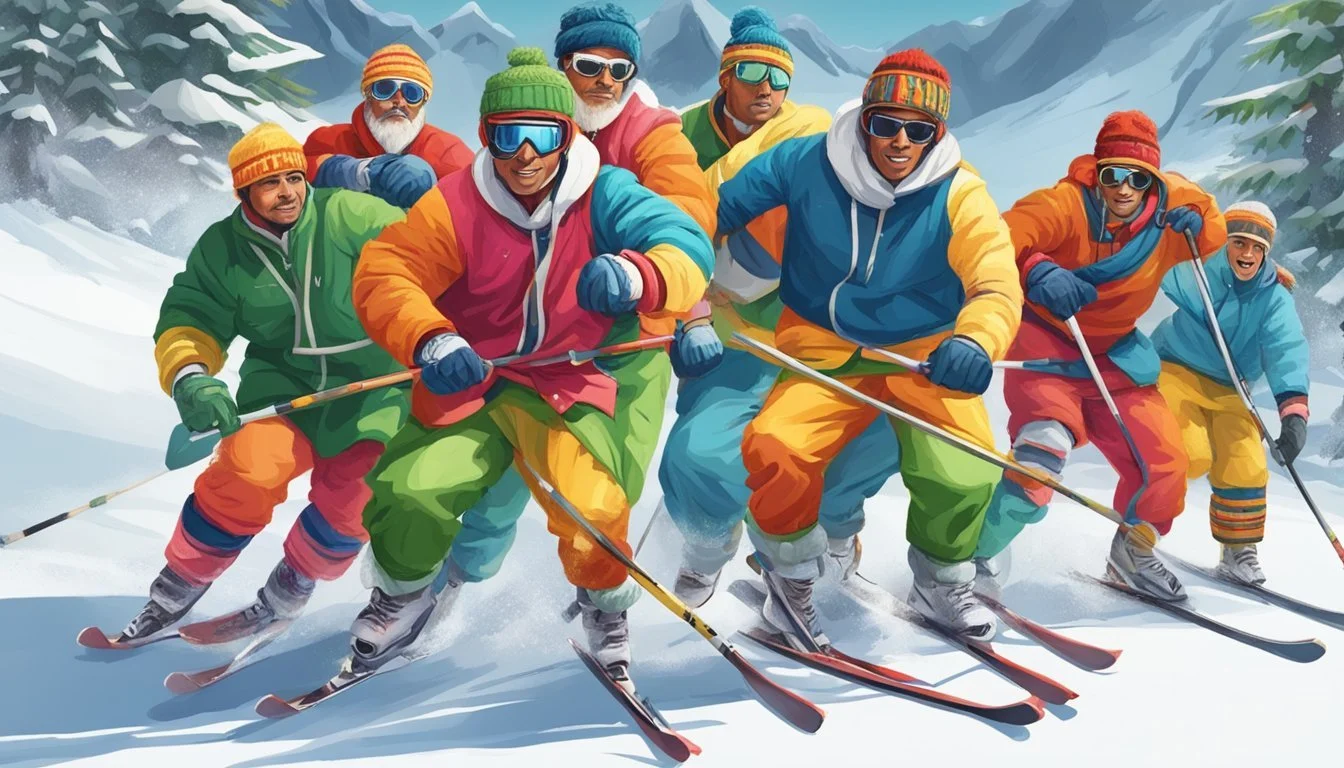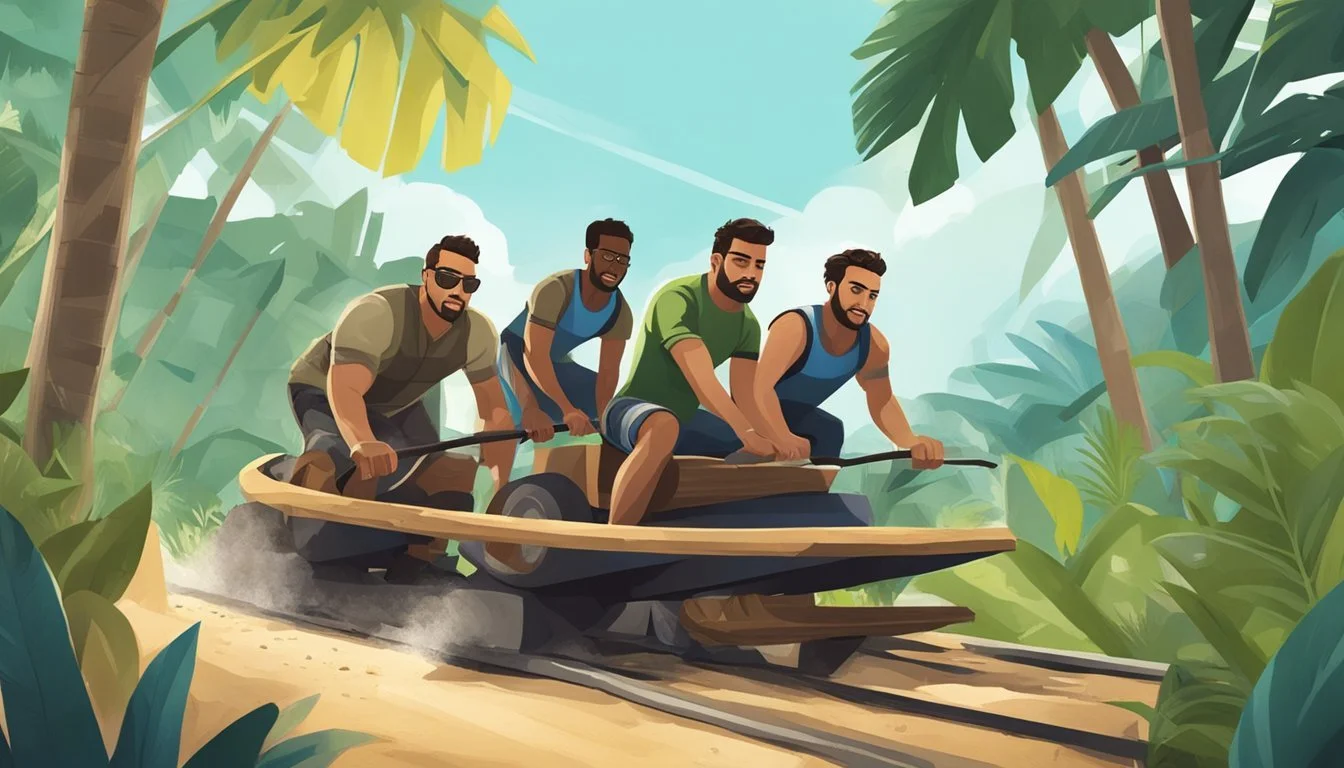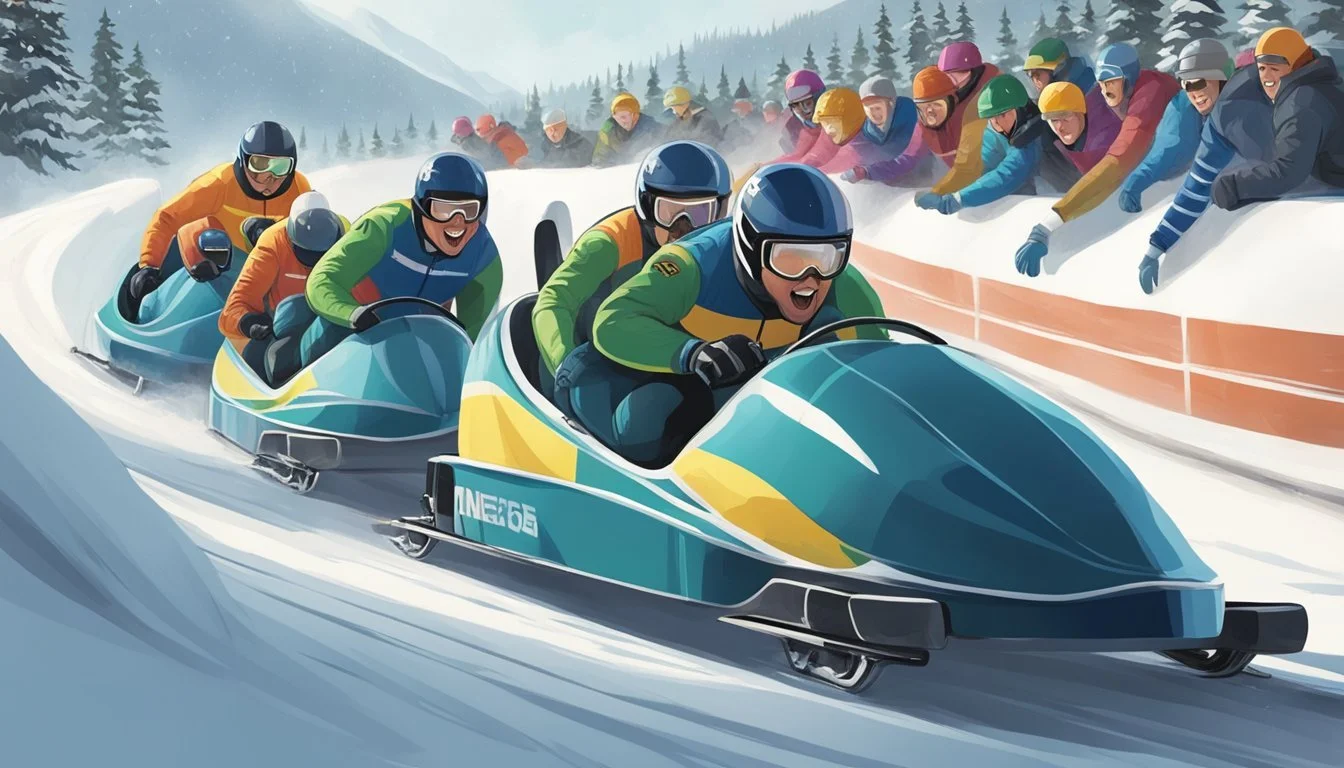Defying Expectations: The True Tale of "Cool Runnings"
Jamaica's Unlikely Olympic Bobsled Journey
The 1993 film "Cool Runnings" captured hearts worldwide with its lighthearted portrayal of Jamaica's first Olympic bobsled team. While the movie took creative liberties, the true story behind it is equally captivating. The real Jamaican bobsled team made their debut at the 1988 Winter Olympics in Calgary, Canada, defying expectations and breaking barriers in a sport traditionally dominated by cold-climate nations.
The team's journey began when two Americans, George Fitch and William Maloney, conceived the idea of forming a Jamaican bobsled team. Unlike the film's depiction, the original team members were not failed sprinters but rather military men recruited for their athletic abilities. Their path to the Olympics was filled with challenges, from learning the basics of bobsledding to overcoming skepticism from both Jamaicans and the international sporting community.
While "Cool Runnings" portrayed a dramatic crash during the final race, the real team's Olympic experience was different. They did not qualify for the four-man event but competed in the two-man bobsled, finishing 30th out of 41 teams. Despite not winning medals, their participation alone was a remarkable achievement, inspiring future generations and cementing their place in Olympic history.
Genesis of 'Cool Runnings'
The creation of "Cool Runnings" began with an unlikely true story that captured Hollywood's imagination. This section explores the origins of the film, from its initial concept to the final casting decisions.
Inspiration Behind The Story
"Cool Runnings" drew inspiration from the real-life Jamaican bobsled team that competed in the 1988 Winter Olympics. The idea for the film came from producer Dawn Steel, who read about the team's journey in a newspaper article. She saw potential in the underdog story of tropical athletes competing in a winter sport.
The true events, however, differed significantly from the movie's portrayal. Only about one percent of the film accurately reflects historical facts. The real team formed through a more conventional recruitment process, unlike the sprinter-turned-bobsledder narrative depicted on screen.
Screenplay Development
Writers Lynn Siefert and Michael Ritchie crafted the initial screenplay, blending fact with fiction to create a compelling narrative. They took creative liberties to enhance the story's entertainment value and emotional impact.
The script underwent several revisions. Tommy Swerdlow and Michael Goldberg later came on board to refine the screenplay. They added humor and heart to the story, creating memorable characters and quotable lines.
The writers faced the challenge of balancing comedy with the serious aspects of the team's struggle. They aimed to capture the spirit of the Jamaican athletes' determination and the cultural clash they experienced.
Casting Choices
The casting process aimed to find actors who could bring authenticity and charm to the fictionalized characters. Leon Robinson was cast as Derice Bannock, the determined leader of the team. Doug E. Doug took on the role of Sanka Coffie, providing comic relief as the pushcart champion.
John Candy, a well-known comedic actor, joined the cast as Irving Blitzer, the disgraced former Olympian turned coach. Candy's involvement added star power to the project and helped attract audience interest.
The casting directors sought actors who could capture the Jamaican spirit and accent. They balanced established talent with fresh faces to create a dynamic on-screen team chemistry.
Historical and Cultural Context
Jamaica's unexpected entry into bobsledding sparked global interest and challenged stereotypes. The team's journey from a tropical island to winter sports showcased cultural adaptability and determination. Their story gained widespread attention, influencing media representation and popular culture.
Jamaica's Bobsleigh Origins
Jamaica's bobsleigh journey began in 1988 when George Fitch and William Maloney had the idea to form a team. They saw potential in using pushcart racers' skills for bobsledding. The Jamaica Olympic Association supported the initiative, despite initial skepticism.
Trials were held to select athletes from various sports backgrounds. Devon Harris, Dudley Stokes, Michael White, and Samuel Clayton made the cut. The team faced numerous challenges, including lack of experience and limited resources.
Their determination led to qualification for the 1988 Winter Olympics in Calgary. This achievement marked a significant milestone in Jamaican sports history.
Representation in Media
The Jamaican bobsleigh team's story captivated global media. News outlets highlighted their underdog status and unique journey. This coverage challenged preconceptions about winter sports participation.
The team's experiences inspired the 1993 film "Cool Runnings." While fictionalized, the movie brought their story to a wider audience. It portrayed themes of perseverance, cultural pride, and breaking barriers.
The film's success further boosted the team's popularity. It also sparked discussions about representation in sports and media. The story became a symbol of pursuing dreams against odds.
1990s Cinematic Landscape
"Cool Runnings" entered a 1990s film landscape rich with sports narratives. The decade saw a surge in inspirational sports movies based on true stories. Films like "A League of Their Own" and "Rudy" were popular.
The movie stood out for its focus on a winter sport from an unexpected source. It blended comedy with uplifting themes, appealing to diverse audiences. The film's success highlighted a growing interest in culturally diverse narratives.
"Cool Runnings" contributed to a trend of feel-good sports comedies. It balanced humor with themes of national pride and personal growth. The film's impact extended beyond entertainment, inspiring future athletes and film narratives.
Production Stages
The production of "Cool Runnings" involved various challenges and creative decisions across multiple locations. Key aspects included selecting filming sites, overcoming obstacles during shooting, and crafting a memorable soundtrack.
Filming Locations
"Cool Runnings" was primarily filmed in Calgary, Alberta, Canada. The city's Olympic facilities from the 1988 Winter Games provided an authentic backdrop for many scenes. Some interior shots were captured at a local high school gymnasium, transformed into a Jamaican setting.
The production team also traveled to Jamaica for establishing shots and cultural authenticity. They filmed in Kingston and other parts of the island to capture the vibrant atmosphere and tropical landscapes.
Challenges During Filming
The film faced several hurdles during production. Creating a convincing winter environment in Calgary's summer months proved difficult. Artificial snow and careful scheduling were necessary to maintain continuity.
Working with inexperienced actors in bobsledding scenes posed safety concerns. Extensive training and the use of stunt doubles were required to ensure realistic performances without compromising safety.
Budget constraints forced creative problem-solving. The team had to be resourceful in recreating Olympic venues and Jamaican locales within their financial limitations.
Music and Soundtrack
The "Cool Runnings" soundtrack played a crucial role in establishing the film's tone. It blended reggae, calypso, and pop music to capture Jamaica's spirit and the excitement of the Olympics.
Hans Zimmer composed the original score, incorporating Caribbean rhythms with orchestral elements. The soundtrack featured popular artists like Jimmy Cliff, whose rendition of "I Can See Clearly Now" became closely associated with the film.
Several original songs were created specifically for the movie, adding authenticity to the Jamaican scenes and enhancing emotional moments throughout the story.
Themes and Motifs
"Cool Runnings" explores powerful themes that resonate with audiences. The film's narrative weaves together messages of perseverance, unity, and challenging preconceptions.
Overcoming Adversity
The Jamaican bobsled team faces numerous obstacles on their journey to the Olympics. They confront financial limitations, lack of proper equipment, and harsh weather conditions unfamiliar to their tropical homeland. The athletes' determination shines as they adapt to these challenges, training creatively with makeshift sleds and enduring grueling practice sessions.
Their coach, Irv Blitzer, also grapples with his past mistakes and seeks redemption. His journey parallels the team's, as he must overcome self-doubt and the stigma of his previous cheating scandal.
These struggles highlight the film's central message: with grit and resilience, one can triumph over seemingly insurmountable odds.
Teamwork and Persistence
The importance of collaboration is a key motif throughout "Cool Runnings". Initially strangers, the four Jamaican athletes learn to work together, synchronizing their movements and supporting each other both on and off the track.
Their bond strengthens as they face setbacks, exemplified by their unity after crashes and disappointments. The team's persistence is evident in their rigorous training montages and their refusal to give up, even when faced with ridicule or failure.
This emphasis on teamwork extends to their relationship with Coach Blitzer. As they learn to trust and rely on each other, their collective strength grows, enabling them to compete at the highest level.
Stereotypes and Prejudices
"Cool Runnings" tackles the issue of stereotypes head-on. The Jamaican team encounters skepticism and prejudice from other athletes and officials who doubt their abilities based on their nationality and inexperience.
The film challenges these preconceptions, showing how the team's unique background becomes their strength. Their laid-back attitude and resourcefulness often give them an edge over more traditional competitors.
Through interactions with other characters, the movie illustrates the importance of looking beyond surface-level judgments. As the team proves their worth, they change perceptions and earn respect, highlighting the film's message about breaking down cultural barriers and embracing diversity in sports.
Reception and Legacy
"Cool Runnings" became a cultural phenomenon, captivating audiences worldwide and leaving a lasting impact on popular culture. The film's box office success, critical reception, and enduring influence transformed it into a beloved classic.
Initial Box Office Reception
"Cool Runnings" debuted in October 1993 and quickly became a sleeper hit. The film grossed over $68 million domestically and $154 million worldwide against a modest $14 million budget. It ranked 5th at the box office in its opening weekend, earning $7 million.
The movie's success surprised many industry experts who had doubted its appeal. Its feel-good story and charming cast resonated with audiences, leading to strong word-of-mouth recommendations.
Critical Acclaim and Criticism
Critics generally praised "Cool Runnings" for its uplifting message and entertaining performances. The film received a 76% approval rating on Rotten Tomatoes. Many reviewers highlighted John Candy's role and the chemistry among the lead actors.
Some critics, however, noted historical inaccuracies and stereotypical portrayals. They argued that the film oversimplified the real story of the Jamaican bobsled team.
Despite these concerns, the movie's positive message of perseverance and sportsmanship was widely appreciated.
Influence on Pop Culture
"Cool Runnings" has maintained a strong presence in popular culture since its release. The film's catchphrases, like "Feel the rhythm, feel the rhyme," became part of everyday language.
The movie inspired increased interest in bobsledding, particularly in non-traditional winter sports countries. It also boosted tourism to Jamaica and raised awareness of the country's Winter Olympics participation.
"Cool Runnings" continues to be referenced in media and sports commentaries, especially during Winter Olympics coverage. Its enduring popularity has led to regular TV reruns and streaming availability, introducing new generations to the story.
Comparisons to Actual Events
The movie "Cool Runnings" took significant creative liberties with the true story of the 1988 Jamaican bobsled team. While the film captured the spirit of their journey, many details were altered or fabricated for dramatic effect.
True Story Versus Film Narrative
The real Jamaican bobsled team was not formed by a disgraced sprinter, as depicted in the movie. Instead, it was the brainchild of two American businessmen and a Jamaican military officer. The team members were recruited from the Jamaican army, not from failed Olympic sprinters.
Unlike the film's portrayal, the Jamaican team received significant support and training from international bobsled organizations. They trained in Austria and Lake Placid before the Olympics, not on a makeshift sled on a local hill.
The dramatic crash scene in the movie did occur in real life, but during the four-man event, not the two-man competition as shown in the film.
Portrayal of Characters
The characters in "Cool Runnings" were largely fictionalized. John Candy's character, Irv Blitzer, was loosely based on Howard Siler, the team's actual coach. However, Siler was not a disgraced former Olympian seeking redemption.
The real team members - Dudley Stokes, Devon Harris, Michael White, and Chris Stokes - had very different backgrounds and personalities from their on-screen counterparts. They were disciplined soldiers, not the ragtag group of underdogs depicted in the film.
The antagonistic relationship with other teams was also exaggerated. In reality, the Jamaican team received support and encouragement from many competitors.
Long-term Impact on the Jamaican Bobsled Team
Despite the film's embellishments, "Cool Runnings" had a significant positive impact on the real Jamaican bobsled program. The movie's popularity brought global attention and support to the team, helping to sustain the program for years to come.
Jamaica has continued to field bobsled teams in subsequent Winter Olympics. The exposure from the film has helped with recruitment and funding, allowing the program to expand and improve over time.
The team's legacy extends beyond bobsledding. Their story has inspired other tropical nations to compete in winter sports, broadening the global appeal of these events.
Behind the Scenes
The making of "Cool Runnings" involved creative choices in direction, cinematography, and post-production that brought the story to life on screen. These elements combined to create the film's distinctive look and feel.
Director's Vision
Jon Turteltaub aimed to balance comedy with heartfelt moments in "Cool Runnings". He focused on character development, ensuring each team member had a unique personality that resonated with audiences. Turteltaub worked closely with the actors to capture authentic Jamaican accents and mannerisms.
The director insisted on shooting some scenes on location in Jamaica to maintain authenticity. He also collaborated with former Olympic bobsledders as technical advisors to accurately portray the sport.
Cinematography Techniques
Cinematographer Phedon Papamichael utilized vibrant colors to contrast Jamaica's tropical setting with the cold, stark environment of the Winter Olympics. Wide shots showcased the beautiful Jamaican landscapes, while tight framing emphasized the cramped bobsled runs.
Papamichael employed handheld cameras during bobsled sequences to convey speed and excitement. Slow-motion shots highlighted key emotional moments and athletic feats.
Lighting played a crucial role, with warm tones for Jamaican scenes and cooler hues for winter settings.
Editing and Post-Production
Editor Bruce Green faced the challenge of maintaining a brisk pace while allowing character moments to breathe. He skillfully interwove comedic scenes with more serious dramatic elements.
The film's soundtrack, featuring reggae and calypso music, was carefully integrated to enhance the Jamaican atmosphere. Sound designers created realistic bobsled sound effects by recording actual sleds on ice tracks.
Visual effects were used sparingly, mainly to enhance winter scenes and create crowd shots for the Olympic sequences. The team prioritized practical effects whenever possible to maintain authenticity.







